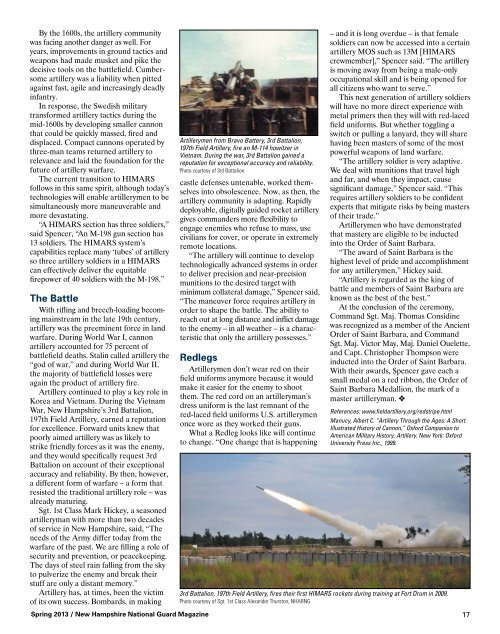New Hampshire National Guard - Spring 2013
New Hampshire National Guard - Spring 2013
New Hampshire National Guard - Spring 2013
You also want an ePaper? Increase the reach of your titles
YUMPU automatically turns print PDFs into web optimized ePapers that Google loves.
By the 1600s, the artillery community<br />
was facing another danger as well. For<br />
years, improvements in ground tactics and<br />
weapons had made musket and pike the<br />
decisive tools on the battlefield. Cumbersome<br />
artillery was a liability when pitted<br />
against fast, agile and increasingly deadly<br />
infantry.<br />
In response, the Swedish military<br />
transformed artillery tactics during the<br />
mid-1600s by developing smaller cannon<br />
that could be quickly massed, fired and<br />
displaced. Compact cannons operated by<br />
three-man teams returned artillery to<br />
relevance and laid the foundation for the<br />
future of artillery warfare.<br />
The current transition to HIMARS<br />
follows in this same spirit, although today’s<br />
technologies will enable artillerymen to be<br />
simultaneously more maneuverable and<br />
more devastating.<br />
“A HIMARS section has three soldiers,”<br />
said Spencer, “An M-198 gun section has<br />
13 soldiers. The HIMARS system’s<br />
capa bilities replace many ‘tubes’ of artillery<br />
so three artillery soldiers in a HIMARS<br />
can effectively deliver the equitable<br />
firepower of 40 soldiers with the M-198.”<br />
The Battle<br />
With rifling and breech-loading becoming<br />
mainstream in the late 19th century,<br />
artillery was the preeminent force in land<br />
warfare. During World War I, cannon<br />
artillery accounted for 75 percent of<br />
battlefield deaths. Stalin called artillery the<br />
“god of war,” and during World War II,<br />
the majority of battlefield losses were<br />
again the product of artillery fire.<br />
Artillery continued to play a key role in<br />
Korea and Vietnam. During the Vietnam<br />
War, <strong>New</strong> <strong>Hampshire</strong>’s 3rd Battalion,<br />
197th Field Artillery, earned a reputation<br />
for excellence. Forward units knew that<br />
poorly aimed artillery was as likely to<br />
strike friendly forces as it was the enemy,<br />
and they would specifically request 3rd<br />
Battalion on account of their exceptional<br />
accuracy and reliability. By then, however,<br />
a different form of warfare – a form that<br />
resisted the traditional artillery role – was<br />
already maturing.<br />
Sgt. 1st Class Mark Hickey, a seasoned<br />
artilleryman with more than two decades<br />
of service in <strong>New</strong> <strong>Hampshire</strong>, said, “The<br />
needs of the Army differ today from the<br />
warfare of the past. We are filling a role of<br />
security and prevention, or peacekeeping.<br />
The days of steel rain falling from the sky<br />
to pulverize the enemy and break their<br />
stuff are only a distant memory.”<br />
Artillery has, at times, been the victim<br />
of its own success. Bombards, in making<br />
Artillerymen from Bravo Battery, 3rd Battalion,<br />
197th Field Artillery, fire an M-114 howitzer in<br />
Vietnam. During the war, 3rd Battalion gained a<br />
reputation for exceptional accuracy and reliability.<br />
Photo courtesy of 3rd Battalion<br />
castle defenses untenable, worked them -<br />
selves into obsolescence. Now, as then, the<br />
artillery community is adapting. Rapidly<br />
deployable, digitally guided rocket artillery<br />
gives commanders more flexibility to<br />
engage enemies who refuse to mass, use<br />
civilians for cover, or operate in extremely<br />
remote locations.<br />
“The artillery will continue to develop<br />
technologically advanced systems in order<br />
to deliver precision and near-precision<br />
munitions to the desired target with<br />
minimum collateral damage,” Spencer said,<br />
“The maneuver force requires artillery in<br />
order to shape the battle. The ability to<br />
reach out at long distance and inflict damage<br />
to the enemy – in all weather – is a characteristic<br />
that only the artillery possesses.”<br />
Redlegs<br />
Artillerymen don’t wear red on their<br />
field uniforms anymore because it would<br />
make it easier for the enemy to shoot<br />
them. The red cord on an artilleryman’s<br />
dress uniform is the last remnant of the<br />
red-laced field uniforms U.S. artillerymen<br />
once wore as they worked their guns.<br />
What a Redleg looks like will continue<br />
to change. “One change that is happening<br />
– and it is long overdue – is that female<br />
soldiers can now be accessed into a certain<br />
artillery MOS such as 13M [HIMARS<br />
crewmember],” Spencer said. “The artillery<br />
is moving away from being a male-only<br />
occupational skill and is being opened for<br />
all citizens who want to serve.”<br />
This next generation of artillery soldiers<br />
will have no more direct experience with<br />
metal primers then they will with red-laced<br />
field uniforms. But whether toggling a<br />
switch or pulling a lanyard, they will share<br />
having been masters of some of the most<br />
powerful weapons of land warfare.<br />
“The artillery soldier is very adaptive.<br />
We deal with munitions that travel high<br />
and far, and when they impact, cause<br />
significant damage,” Spencer said. “This<br />
requires artillery soldiers to be confident<br />
experts that mitigate risks by being masters<br />
of their trade.”<br />
Artillerymen who have demonstrated<br />
that mastery are eligible to be inducted<br />
into the Order of Saint Barbara.<br />
“The award of Saint Barbara is the<br />
highest level of pride and accomplishment<br />
for any artillerymen,” Hickey said.<br />
“Artillery is regarded as the king of<br />
battle and members of Saint Barbara are<br />
known as the best of the best.”<br />
At the conclusion of the ceremony,<br />
Command Sgt. Maj. Thomas Considine<br />
was recognized as a member of the Ancient<br />
Order of Saint Barbara, and Command<br />
Sgt. Maj. Victor May, Maj. Daniel Ouelette,<br />
and Capt. Christopher Thompson were<br />
inducted into the Order of Saint Barbara.<br />
With their awards, Spencer gave each a<br />
small medal on a red ribbon, the Order of<br />
Saint Barbara Medallion, the mark of a<br />
master artilleryman. v<br />
References: www.fieldartillery.org/redstripe.html<br />
Manucy, Albert C. “Artillery Through the Ages: A Short<br />
Illustrated History of Cannon,” Oxford Companion to<br />
American Military History: Artillery. <strong>New</strong> York: Oxford<br />
University Press Inc., 1999.<br />
3rd Battalion, 197th Field Artillery, fires their first HIMARS rockets during training at Fort Drum in 2009.<br />
Photo courtesy of Sgt. 1st Class Alexander Thurston, NHARNG<br />
<strong>Spring</strong> <strong>2013</strong> / <strong>New</strong> <strong>Hampshire</strong> <strong>National</strong> <strong>Guard</strong> Magazine 17

















